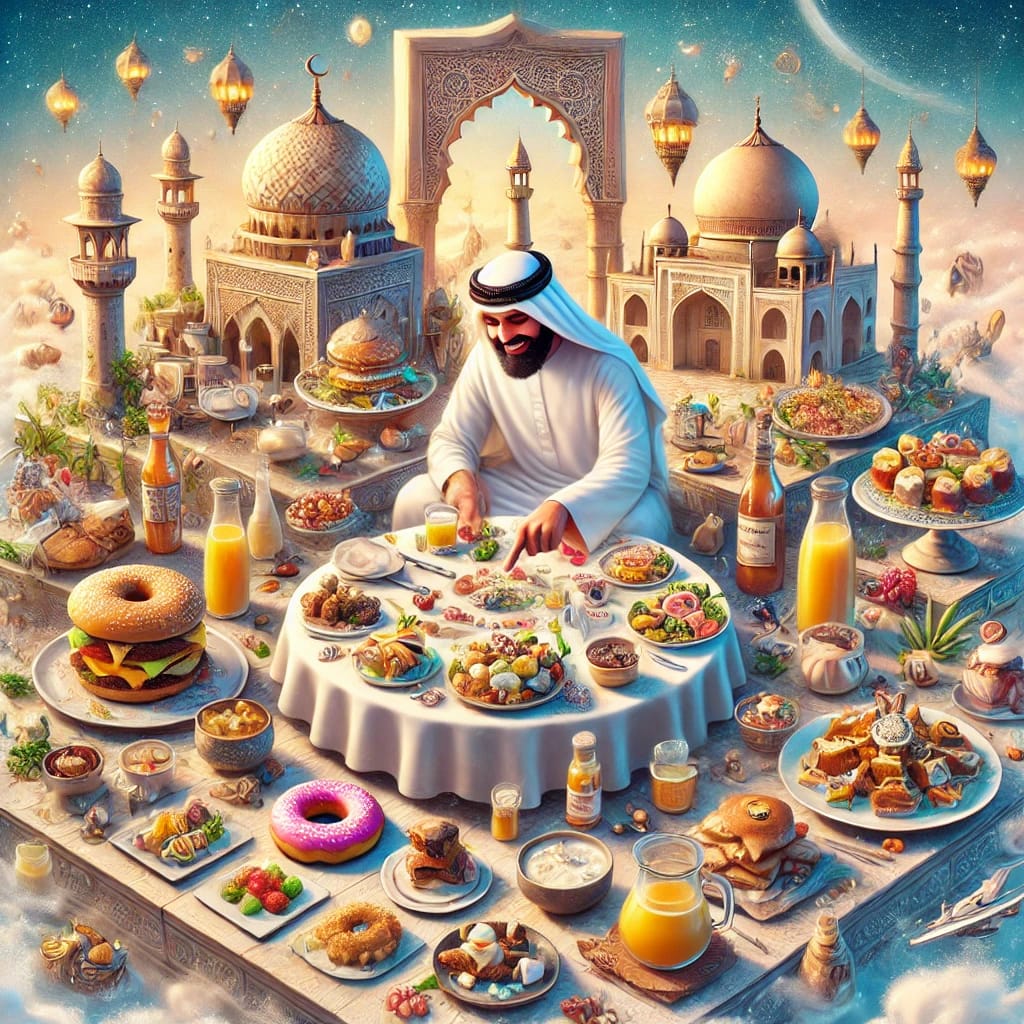
A Royal Feast in an Arabian Dreamscape: A Culinary Journey Through Culture and Flavor
The image before us is nothing short of a mesmerizing fusion of Arabian heritage and extravagant gastronomy. It depicts a lavish feast set against a breathtaking fantasy backdrop featuring grand Islamic architecture, ornate lanterns glowing in the sky, and a dreamlike atmosphere where clouds meet the golden sands of the desert. At the heart of this scene sits a man dressed in traditional white attire, radiating hospitality as he enjoys an elaborate meal that combines traditional Middle Eastern dishes with modern international delicacies.
This visual masterpiece encapsulates the essence of Arabian luxury, where food is not just sustenance but a celebration of culture, hospitality, and artistic presentation. The table is adorned with a vast array of dishes, each meticulously crafted to highlight flavors from different corners of the world, making this meal a true gastronomic spectacle.
The Essence of Arabian Hospitality: More Than Just a Meal
In Arab culture, food is a symbol of generosity and warmth, an offering that brings families and friends together. The grand spread in the image reflects the core values of Arabian hospitality, where guests are welcomed with an abundance of dishes, from sweet and savory to fresh and aromatic. The attention to detail in this scene illustrates the importance of communal dining, an age-old tradition in the Middle East where meals are shared, and conversations flow freely over plates of indulgence.
The dishes on the table range from traditional Arabian staples to international delights, reflecting a perfect harmony between heritage and modern influence. There are golden-brown samosas, crispy on the outside and bursting with flavorful fillings; platters of grilled meats, marinated with rich spices; and bowls of hummus, creamy and garnished with pomegranate seeds. The presence of vibrant desserts, fresh juices, and aromatic tea completes the luxurious dining experience.
A Breakdown of the Extravagant Feast
Let’s take a closer look at the key elements that make this spread truly magnificent:
1. Traditional Middle Eastern Delicacies
- Hummus & Mutabbal
- – Smooth, creamy, and drizzled with olive oil, these dips are an essential part of Arabic cuisine.
- Falafel
- – Deep-fried chickpea patties, crisp on the outside and soft on the inside, served with tahini sauce.
- Manakish
- – A Levantine flatbread topped with za’atar, cheese, or minced meat, a favorite breakfast dish.
- Samosas
- – Stuffed pastries with spiced meat, potatoes, or lentils, often served as appetizers.
- Stuffed Grape Leaves (Warak Enab) – A delicate combination of rice, herbs, and sometimes meat wrapped in grape leaves, offering a burst of flavor in every bite.
2. Grilled Meats and Kebabs
- Lamb and Chicken Kebabs – Succulent skewers of marinated meats grilled to perfection.
- Shawarma
- – Slices of slow-roasted meat, served with pita bread, garlic sauce, and pickles.
- Mixed Grill Platter
- – A variety of meats, including lamb chops, beef kofta, and shish taouk, served with aromatic rice and grilled vegetables.
3. International Fusion Additions
While the foundation of the feast is deeply rooted in Middle Eastern cuisine, there is an evident fusion of global flavors:
- Burgers
- – A modern twist to the traditional spread, showing the influence of Western cuisine.
- Donuts and Pastries
- – A vibrant selection of sweets, adding a playful and colorful element to the meal.
- Cheesecakes & French Pastries – Indulgent desserts that reflect the global reach of culinary excellence.
4. Beverages & Accompaniments
- Fresh Orange Juice
- – Bright and refreshing, complementing the rich flavors of the dishes.
- Arabic Coffee (Qahwa)
- – A symbol of hospitality, served in small cups with dates.
- Tea with Mint
- – A staple in Arab households, offering a soothing end to the meal.
A Feast for the Senses: The Aesthetic and Cultural Significance
Beyond the diverse and sumptuous spread, the overall presentation plays a crucial role in enhancing the dining experience. The grand table setting, the flowing white tablecloth, and the luxurious cutlery elevate the sense of opulence. The background architecture, reminiscent of iconic Islamic landmarks like the Taj Mahal and Alhambra, adds a mystical aura to the scene, symbolizing the deep historical connection between food, tradition, and artistic expression.
The use of warm, golden hues in the lighting creates an ambiance of comfort and festivity, while the floating lanterns evoke a feeling of a dreamlike Arabian night. The imagery suggests a utopian blend of past and present, where age-old culinary traditions seamlessly merge with modern-day extravagance.
The Message Behind the Image: A Celebration of Culture and Togetherness
At its core, this image is more than just a depiction of food; it is a representation of unity, hospitality, and the joy of sharing. Whether it’s the rich textures of the dishes, the grandeur of the setting, or the serene expression of the host, every element contributes to the larger narrative of cultural pride and inclusivity.
In many ways, this scene invites the viewer to step into a world where food transcends borders, where flavors from different cultures come together to create something truly magnificent. It speaks to the power of culinary art as a universal language, capable of bringing people together, regardless of background or tradition.
Conclusion: A Culinary Dream Brought to Life
This image is a stunning portrayal of a dining experience that is as rich in flavor as it is in culture. From the intricate architecture to the indulgent spread of food, every detail is meticulously crafted to convey a sense of abundance, tradition, and artistic splendor.
It serves as a reminder of the beauty of sharing meals, the importance of preserving culinary heritage, and the endless possibilities of combining tradition with innovation. Whether viewed as a piece of art or a reflection of real-life Arabian hospitality, this feast is a celebration of life, food, and the bonds that unite us all.
Would you accept an invitation to such a feast?

